The Economics and Statistics Division maintains archives of previous publications for accountability purposes, but makes no updates to keep these documents current with the latest data revisions from Statistics Canada. As a result, information in older documents may not be accurate. Please exercise caution when referring to older documents. For the latest information and historical data, please contact the individual listed to the right.
<--- Return to Archive
For additional information relating to this article, please contact:
November 21, 2017INVESTMENT IN NEW HOUSING CONSTRUCTION, SEPTEMBER 2017 

Investment in new housing construction in Nova Scotia (current dollars, unadjusted for seasonality) increased by 17.7 per cent in September 2017 compared to September 2016 to $75.9 million. Investment in new single-detached units increased by 5.7 per cent to $39.9 million, while investment in apartment units increased by 43.3 per cent to $29.8 million. The relatively smaller semi-detached segment was up 9.0 per cent to $4.0 million with row housing construction dipped 1.1 per cent to $2.2 million. In Canada, new housing investment increased by 8.9 per cent over the same period.
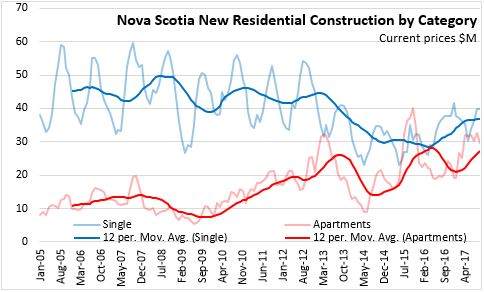
The composition of Nova Scotia's housing construction has been changing over the last decade, beginning with a rise in apartment construction in 2009. The pace of single dwelling construction slowed in 2013 as apartments reached a peak. Total construction was down in both categories for 2014, followed by a rebound in apartment construction in 2015. In 2016 and 2017, single dwelling construction has rebounded, though not to the same pace as was observed over a decade ago. After declining in late 2016, apartment construction has risen again in 2017.
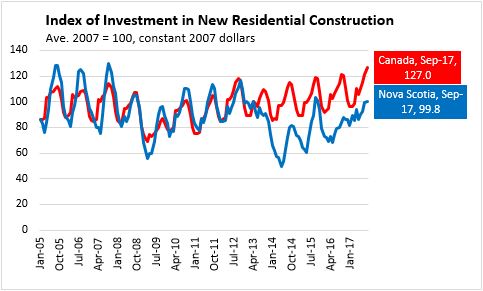
The trend in Nova Scotia's housing construction (measured using an index of investment in all dwellings) shows both the strong seasonal pattern as well as the difference from national levels. While national new housing construction grew rapidly from 2013 onwards (particularly in larger urban centres), Nova Scotia's housing markets have grown more slowly as there was a shift in composition between apartment and single dwelling unit construction.
On a year-to-date basis, Nova Scotia's total new housing construction is up 23 per cent, or $118.7 million, compared with the first three quarters of 2016. Growth is mainly attributable to a $44.6 million increase in spending on single dwelling units and a $71.3 million increase in apartment spending. Semi-detached unit spending was up $6.1 million while row housing expenditures fell $3.3 million.
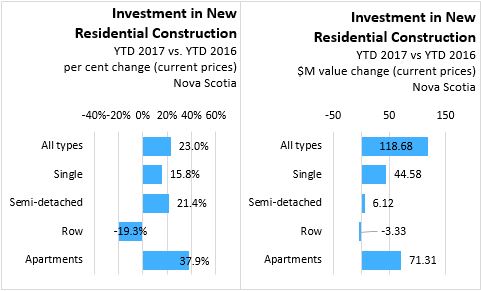
Across Canada, year-to-date investment in new housing construction is up 8.6 per cent or $3.33 billion, with the gains mostly concentrated in single dwelling units.
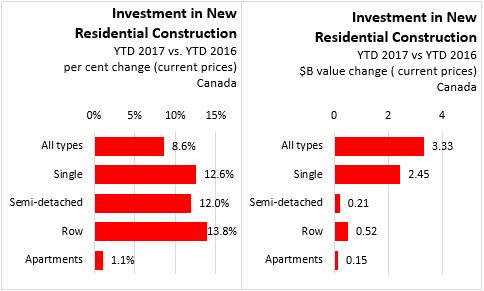
Looking across the country, eight provinces saw an increase in investment in September 2017 compared to September 2016, led by Prince Edward Island, Manitoba, and Alberta. New housing investment in Newfoundland and Labrador declined 12.2 per cent compared to September 2016.

On a year-to-date basis, nine provinces saw an increase in investment in the first three quarters of 2017 compared to the same period in 2016, led by Prince Edward Island, Manitoba, Nova Scotia, Quebec and Ontario. Only Newfoundland and Labrador has reported lower year-to-date new housing construction totals.
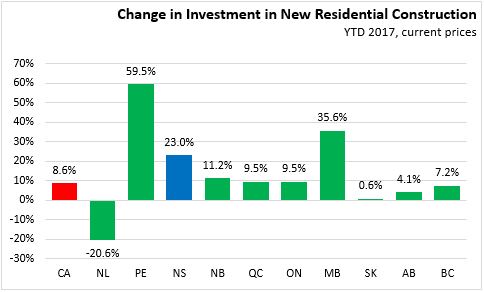
Statistics Canada CANSIM 026-0017
<--- Return to Archive